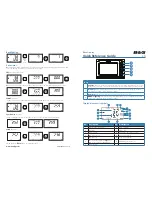
Cinterion
®
ELS31-VA/ELS51-VA Hardware Interface Description
2.1 Application Interface
56
ELS31-VA_ELS51-VA_HID_v01.000
2017-01-04
Confidential / Preliminary
Page 27 of 106
2.1.5
Serial Interface ASC1
ELS31-VA/ELS51-VA provides a 4-wire unbalanced, asynchronous modem interface ASC1
conforming to ITU-T V.24 protocol DCE signaling. The electrical characteristics do not comply
with ITU-T V.28. The significant levels are 0V (for low data bit or active state) and 1.8V (for high
data bit or inactive state). For electrical characteristics please refer to
. For an illustra-
tion of the interface line’s startup behavior see
. ASC1 can only be used as data inter-
face.
The ASC1 interface lines are originally available as GPIO lines. If configured as ASC1 lines,
the GPIO lines are assigned as follows: GPIO16 --> RXD1, GPIO17 --> TXD1, GPIO18 -->
RTS1 and GPIO19 --> CTS1. Configuration is done by AT command (see
: AT^SCFG). The
configuration is non-volatile and becomes active after a module restart.
ELS51-VA is designed for use as a DCE. Based on the conventions for DCE-DTE connections
it communicates with the customer application (DTE) using the following signals:
•
Port TXD @ application sends data to module’s TXD1 signal line
•
Port RXD @ application receives data from the module’s RXD1 signal line
Figure 8:
Serial interface ASC1
Features
•
Includes only the data lines TXD1 and RXD1 plus RTS1 and CTS1 for hardware hand-
shake.
•
On ASC1 no RING line is available.
•
Configured for 8 data bits, no parity and 1 or 2 stop bits.
•
ASC1 can be operated at fixed bit rates from 4800 bps to 921600 bps.
•
Supports RTS1/CTS1 hardware flow control. Communication is possible by using only RXD
and TXD lines, if RTS1 is pulled low.
•
Wake up from SLEEP mode by RTS0 activation (high to low transition; see
AT commands for signaling are not supported on ASC1 interface. ASC1 is intended only for
data transfer in a Linux environment.
The following figure shows the startup behavior of the asynchronous serial interface ASC1.
















































